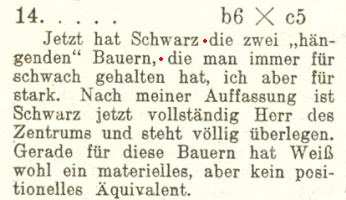
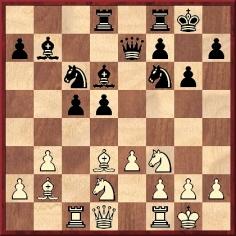
Edward Winter
From our feature article on The Batsford Chess Encyclopedia by Nathan Divinsky (London, 1990):
‘Page 81 reports that Steinitz used the term hanging pawns, but page 144 states that Nimzowitsch introduced it.’
If the page references are replaced by 135 and 213, the comment of ours also applies to The Encyclopedia of Chess by Harry Golombek (London, 1977). That is no great surprise, given that so much of Golombek’s book was repeated by Divinsky, without acknowledgement or care.
On the substantive matter of when, and by whom, the term ‘hanging pawns’ was first used, the earliest citation that we can currently offer (‘die zwei “hängenden” Bauern’) is on page 56 of Das Grossmeisterturnier zu St Petersburg by Siegbert Tarrasch (Nuremberg, 1914) after 14...bxc5 in Tarrasch’s notes to his game (as Black) against Nimzowitsch:


(5725)
Hans-Georg Kleinhenz (Munich, Germany) quotes two instances of the term ‘hanging pawns’ from 1905:
Deutsche Schachzeitung, February 1905, page 40 (note to White’s 15th move in the second match-game between Janowsky and Marshall):
‘Weiß macht dem Gegner “hängende” Bauern.’
Wiener Schachzeitung, March 1905, pages 75-76 (quoting from the Münchener Neueste Nachrichten):
‘... Dagegen ist Janowski einer der hervorragendsten Vertreter der neuen Schule. Sein Spiel regelt sich vor allem nach schachwissenschaftlichen Grundsätzen, es ist System und Methode darin. Er bemüht sich fortwährend, die allgemein anerkannten Prinzipien zur Geltung zu bringen, “die zwei Läufer”, die Bauernmajorität auf dem Damenflügel, rückständige “hängende” Bauern des Gegners zu erreichen, er strebt nach kleinen Teilerfolgen und Akkumulirung derselben. Er spielt wissenschaftlich farblos, objektiv.’
(5731)
No occurrence of the term ‘hanging pawns’ has yet been found in the writings of Steinitz, but Harrie Grondijs (Rijswijk, the Netherlands) mentions that Steinitz’s annotations to the game Mason v Zukertort, London, 30 April 1883 on page 339 of the Turf, Field and Farm, 18 May 1883 recognized the concept of hanging pawns and called them ‘not so strong’.
The opening moves were 1 c4 e6 2 e3 Nf6 3 Nf3 d5 4 d4 Be7 5 Nc3 O-O 6 Bd3 b6 7 cxd5 exd5 8 Ne5 Bb7 9 O-O c5
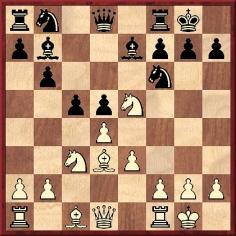
Now Mason played 10 Bd2, and Steinitz wrote:
‘10 dxc5 is, we believe, preferable. The centre pawns are not so strong when isolated.’
After 10 Bd2 Black played 10...Nc6, and Steinitz remarked:
‘He should not have given him another chance of exchanging pawns, and it was better to advance 10...c4 at once.’
(5740)
The earliest use of the term ‘hängende Bauern’ found so far dates from 1905, but for the first instance in English our best offer at present is on page 84 of The Book of the London International Chess Congress 1922 by G. Maróczy (London, 1923), in the notes to the game between H.E. Atkins and C.G. Watson:
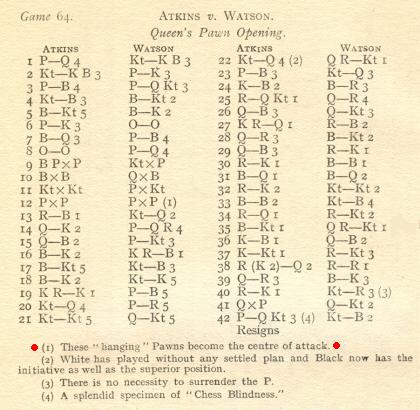
(6559)
Thomas Niessen (Aachen, Germany) notes an earlier occurrence of the term ‘hanging pawns’, including a reference to Steinitz, on page 143 of the July-August 1902 Wiener Schachzeitung, in a note to 20...fxe5 in Gunsberg v Tarrasch, Monte Carlo, 8 February 1902:
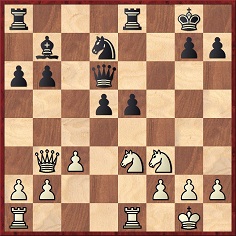
‘Daher wohl der Ausdruck “hängende Bauern”, mit welchen Steinitz die Schwäche derartiger Bauernstellungen unübertrefflich scharf angedeutet hat.’
(9920)
Assertions in The Encyclopedia of Chess by Harry Golombek (London, 1977) and The Batsford Chess Encyclopedia by Nathan Divinsky (London, 1990):
Divinsky (entry on hanging pawns, page 81): ‘Steinitz used this term ...’
Divinsky (entry on Nimzowitsch, page 144): ‘Nimzowitsch introduced into chess terminology such phrases as ... “hanging pawns” ...’
The discrepancy in the Golombek book was pointed out by W.H. Cozens on page 400 of the September 1978 BCM but remained in the 1981 paperback edition (page 199 and page 308).
From page 98 of Pocket Book of Chess by Raymond Keene (London, 1988):
‘The term “hanging pawns” was coined by Wilhelm Steinitz, who was world champion from 1886 to 1894.’
In short, plenty of claims, contradictions and copying, but no corroboration.
So far, the earliest known instance (shown by Thomas Niessen in C.N. 9920) is dated 1902, i.e. post-Steinitz and pre-Nimzowitsch.
(9941)
There is a difference between ‘hanging pawns’ and ‘pawns hanging’, and we wonder how far back one can trace the verb ‘to hang’ in the sense of to leave en prise or to leave a resource open to the opponent, as in expressions such as White ‘hung a rook’, ‘left his queen hanging’ or, indeed, ‘left a mate in one hanging’.
(12004)
To the Chess Notes main page.
To the Archives for other feature articles.
Copyright: Edward Winter. All rights reserved.